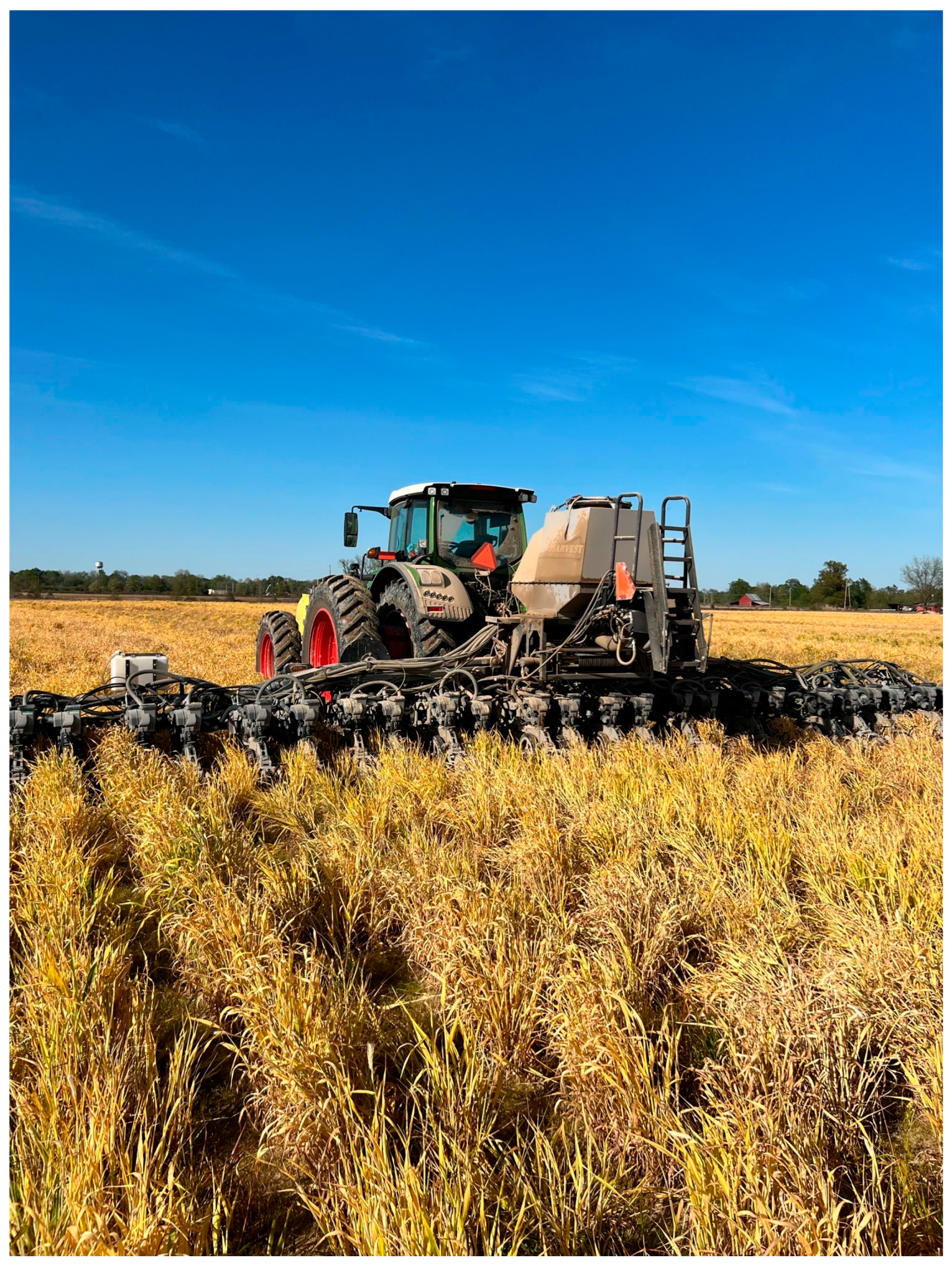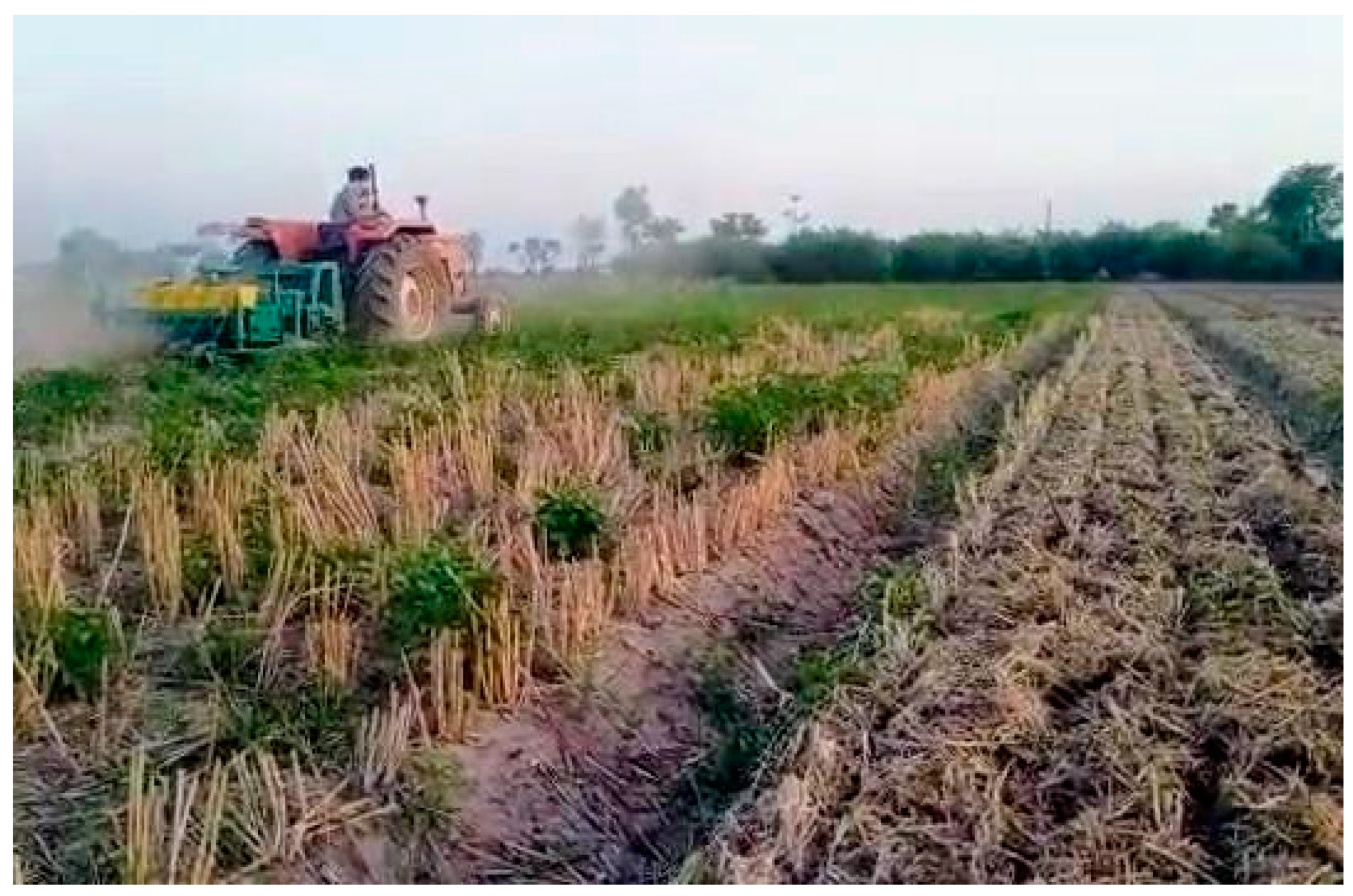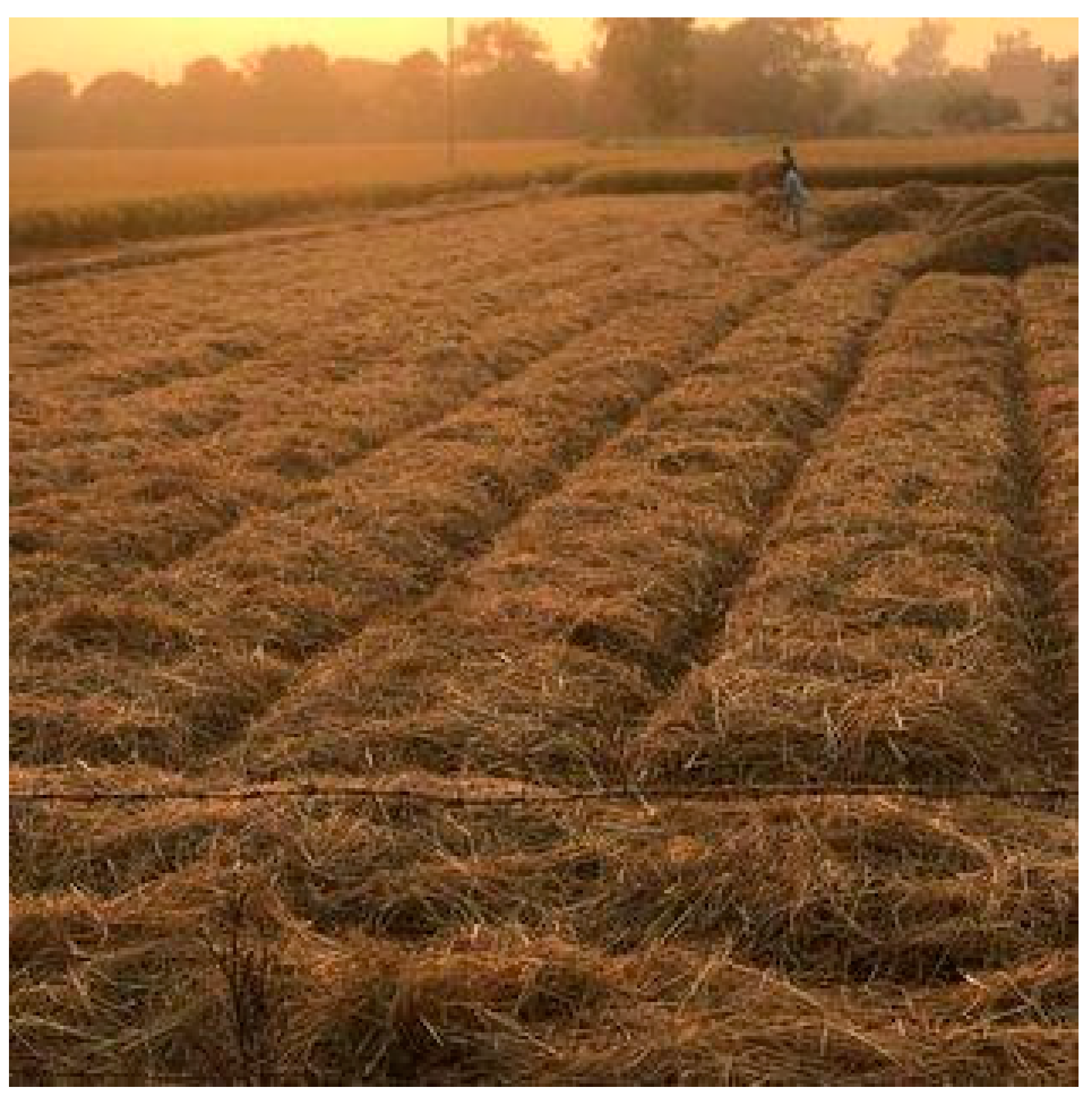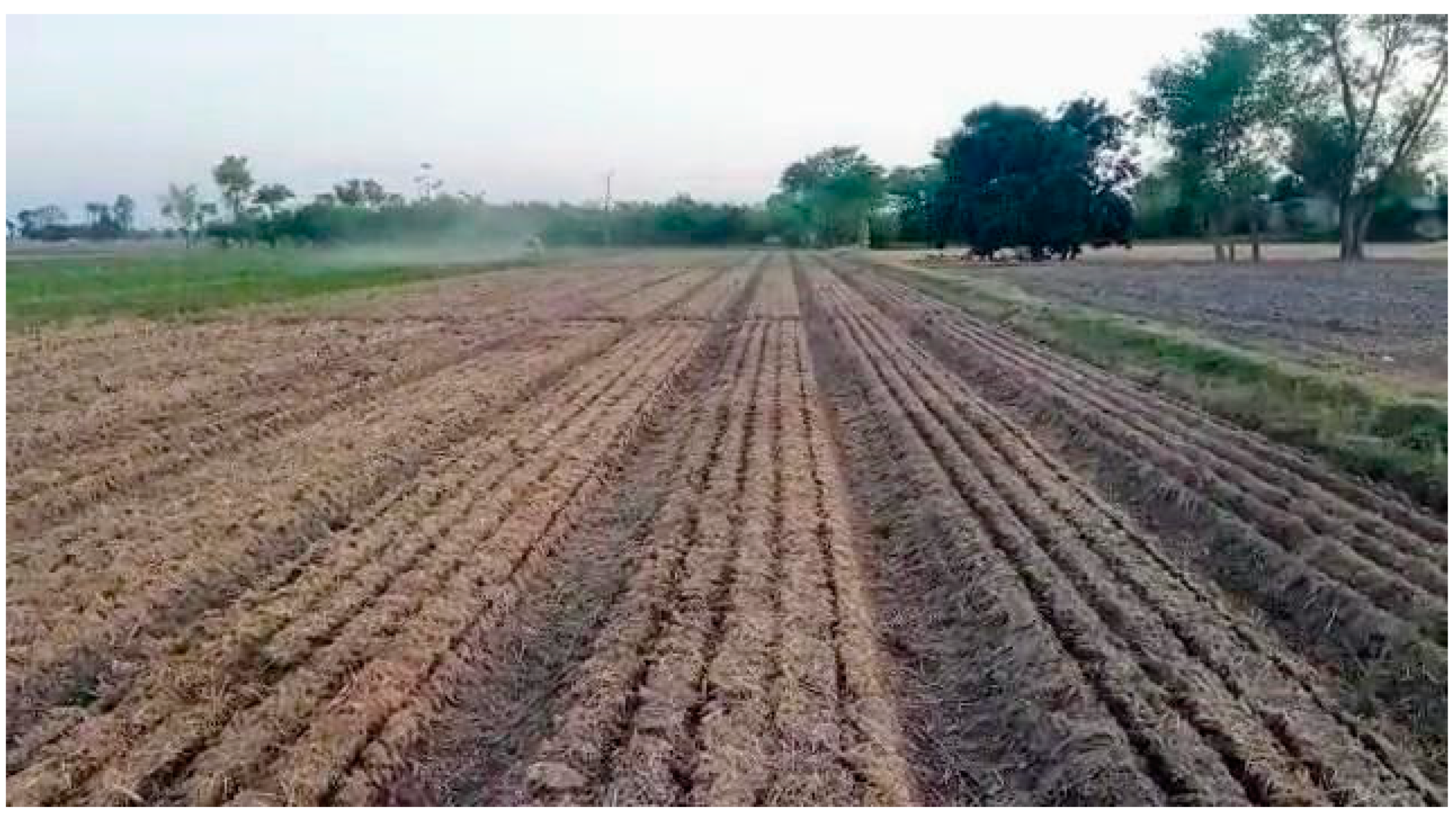Submitted:
22 September 2023
Posted:
25 September 2023
You are already at the latest version
Abstract
Keywords:
1. Introduction
1.1. Conservation Agriculture (CA)
1.2. System of Rice Intensification (SRI)
- Early and careful establishment of single plants to preserve and mobilize their inherent growth potential for tillering and root development. Seedlings are transplanted before they start their 4th phyllochron of growth, i.e., beyond about 15 days after sowing, so as not to lose some of their potential for growth [38,39].
- Minimize competition among plants by reducing plant density m-2 by wider spacing between plants and hills, allowing for development of larger canopies and root systems. Spacing is to be optimized, however, not maximized. Best spacing for single-plant hills, established in a square grid pattern, is usually about 25 × 25 cm, having 16 plants m-2.
- Maintain mostly aerobic soil conditions, balancing the availability of water and oxygen in the soil to avoid the suffocation and degeneration of rice plant roots as well as of soil organisms such as bacteria and earthworms. In irrigated rice production, this involves alternate wetting and drying (AWD) or intermittent irrigation. Weeds are generally controlled with mechanical weeders in perpendicular directions, which causes surface soil aeration. Where there is no irrigation, SRI practices can be adapted for rainfed conditions.
- Build up the soil’s fertility by (a) enhancing soil organic matter to nourish the plants and soil biota, and (b) maintaining the soil in mostly aerobic condition.
2. Compatibility between CA and SRI
2.1. Avoiding Mechanical Soil Disturbance
2.2. Water Management
2.3. Permanent Soil Cover
2.4. Diversification of the cropping system
3. Some Examples
3.1. Pakistan
3.2. U.S.A.

3.3. China
3.4. Vietnam
3.5. Other Examples
4. Conclusion
References
- PES-Food. From Uniformity to Diversity: A Paradigm Shift from Industrial Agriculture to Diversified Agroecological Systems. International Panel of Experts on Sustainable Food Systems. Louvain-la-Neuve, Belgium, 2016. Available at https://www.ipes-food.org/img/upload/files/UniformityToDiversity_FULL.pdf (accessed 1 June 2023).
- FAO. World Food and Agriculture – Statistical Yearbook 2022, 2022. UN Food Agric. Org., Rome. Available at: https://doi.org/10.4060/cc2211en (accessed 1 June 2023).
- IPCC. Climate Change 2022: Impacts, Adaptation, and Vulnerability. Contribution of Working Group II to the Sixth Assessment Report of the Intergovernmental Panel on Climate Change, 2022. Cambridge University Press, Cambridge, UK.
- Searchinger, T.; Waite, R.; Hanson, C.; Ranganathan, J. Creating a Sustainable Food Future: A Menu of Solutions to Feed Nearly 10 Billion People by 2050. 2019, World Resources Institute, Washington, DC.
- Litovsky, A.; Donika, D.; Micklethwaite, K. Financing Sustainable Rice for a Secure Future: Innovative Finance Partnerships for Climate Mitigation and Adaptation, 2019. Earth Security Group, London.
- Surendran, U.; Raja, P.; Jayakumar, M.; Subramaniam, S.R. Use of efficient water- saving techniques for production of rice in India under climate change scenario: A critical review. J. Cleaner Prod. 2021, 309, 127272. [Google Scholar] [CrossRef]
- Sharma, P.K.; De Datta, S.K. Effect of puddling on soil physical properties and processes. In: Soil Physics and Rice. 217-234, 1985, International Rice Research Institute (IRRI), Los Banos Laguna, Philippines.
- Sharma, P.K.; Ladha, J.K.; Bhushan, L. Soil physical effects of puddling in rice–wheat cropping systems. In: Improving the Productivity and Sustainability of Rice-Wheat Systems: Issues and Impacts, Ladha, J.K. et al., eds., 97-113, 2003, Wiley, New York.
- Gregory, D.I.; Haefele, S.M.; Buresh, R.J.; Singh, U. Fertilizer use, markets, and management. In: Rice in the Global Economy: Strategic Research and Policy Issues for Food Security 2010, 231-263. Int. Rice Res. Inst., Los Baños, Philippines.
- Uphoff, N.; Fasoula, V.; Iswandi, A.; Kassam, A.; Thakur, A.K. Improving the phenotypic expression of rice genotypes: Rethinking ‘intensification’ for production systems and selection practices for rice breeding. Crop J. 2015, 3, 174–189. [Google Scholar] [CrossRef]
- Kesavan, P. C.; Swaminathan, M. S. Modern technologies for sustainable food and nutrition security. Curr. Sci. 2018, 115, 1876. [Google Scholar] [CrossRef]
- FAO. Save and Grow in Practice—Maize, Rice, Wheat: A Guide to Sustainable Cereal Production, 44-47, 2016. UN Food Agric. Org., Rome. Available at: http://www.fao.org/3/i4009e/i4009e.pdf (accessed 1 June 2023).
- Pimbert, M. Agroecology as an alternative vision to conventional development and climate-smart agriculture. Development, 2015, 58, 286–298. [Google Scholar] [CrossRef]
- Niggli, U.; Sonnevelt, M.; Kummer, S. Pathways to advance agroecology for a successful transformation to sustainable food systems. In: Science and Innovations for Food Systems Transformation, von Braun, J. et al., eds., vol. 1, 341-359, Springer Link, 2023.
- Sinclair, F.; Wezel, A.; Mbow, C.; Chomba, S., Robiglio, V.; Harrison, R. The Contribution of Agroecological Approaches to Realizing Climate-Resilient Agriculture. 2019, Global Center on Adaptation, Rotterdam and Washington, DC. Available online at https://gca.org/wp-content/uploads/2020/12/TheContributionsOfAgroecologicalApproaches.pdf (accessed 1 June 2023).
- FAO. Climate-Smart Agriculture: Policies, Practices and Financing for Food Security, Adaptation and Mitigation, 2010. UN Food Agric. Org., Rome. Available at: http://www.fao.org/docrep/013/i1881e/i1881e00.htm (accessed 1 June 2023).
- GACSA. Framework Document, Global Alliance for Climate-smart Agriculture, UN Food Agric. Org., Rome 2014. http://www.fao.org/gacsa/en/ (accessed 1 June 2023).
- Kassam, A.; Kassam, L. Practice and benefits of Conservation Agriculture systems. In: Advances in Conservation Agriculture, vol .2, Kassam, A. ed., 2020. Burleigh Dodds, Cambridge, UK.
- Kimaro, A.A.; Mpanda, M.; Rioux, J. et al. Is conservation agriculture 'climate-smart' for maize farmers in the highlands of Tanzania? Nutr. Cycl. Agroecosyst., 2015, 105, 217–228. [Google Scholar] [CrossRef]
- Mishra, A.; Ketelaar, J.W.; Whitten, M. System of Rice Intensification. In: Practical Solutions for Climate Mitigation and Adaptation, Nagothu, U.S., ed., 87-105, 2022. Routledge, Oxfordshire, UK.
- Hoang, V.P.; Xuan, L.H.; Thu, T.L. The advantages of the System of Rice Intensification (SRI) in environmental protection and climate change mitigation in rice production – A review. Thai Nguyen Univ. J. Sci. Technol. 2021, 226, 11–21. [Google Scholar] [CrossRef]
- Kassam, A.; Friedrich, T.; Derpsch, R. Successful experiences and lessons from Conservation Agriculture worldwide. Agronomy, 2022, 12, 769. [Google Scholar] [CrossRef]
- Meyer, R. Agricultural Technologies for Developing Countries. Science and Technology Option Assessment, 2009. European Parliament, Brussels.
- Uphoff, N.; Kassam, A. Case Study: System of Rice Intensification, Agricultural Technologies for Developing Countries, Annex 3, Science and Technology Option Assessment, 2009, European Parliament, Brussels.
- Sharif, A. Technical adaptations for mechanized SRI production to achieve water saving and increased profitability in Punjab, Pakistan. Paddy Water Envir., 2011, 9, 111–119. [Google Scholar] [CrossRef]
- Meyer, R.; Ratinger, T.; Voss-Fels, P. Technology Options for Feeding 10 Billion People: Plant Breeding and Innovative Agriculture. Science and Technology Option Assessment, 2013, European Parliament, Brussels.
- Sharif, A.; Kassam, A.; Friedrich, T.; Uphoff, N.; Joshi, R. C.; Sahu, P. Towards the integration of the System of Rice Intensification (SRI) and Conservation Agriculture (CA) in the Indus Basin in Pakistan Punjab. Fiji Agric. J., 2014, 54, 48–52. [Google Scholar]
- Kassam, A.; Brammer, H. Environmental implication of three modern agricultural practices: Conservation Agriculture, the System of Rice Intensification, and precision agriculture. Int. J. Envir. Studies, 2016, 73, 702–718. [Google Scholar] [CrossRef]
- Styger, E.; Uphoff, N. The System of Rice Intensification (SRI): Revisiting Agronomy for a Changing Climate. 2016, Practice Brief on Climate-Smart Agriculture. Global Alliance on Climate-Smart Agriculture, FAO, Rome.
- Singh, S.K. Profitable rice farming through System of Rice Intensification (SRI) under Conservation Agriculture. In: Conservation Agriculture Mitigating Climate Change Effects and Doubling Farmers’ Income, Mishra, J.S. et al., eds., 233-237, 2018, ICAR Research Complex for Eastern Region, Patna.
- Kassam, A. ed. Advances in Conservation Agriculture, vol. 1 and vol. 2. 2020. Burleigh Dodds, Cambridge, UK.
- Kassam, A. ed. Advances in Conservation Agriculture, vol. 3, Burleigh-Dodds, Cambridge, UK, 2022.
- Uphoff, N.; Kassam, A.; Harwood, R. (2011). SRI as a methodology for raising crop and water productivity: Productive adaptations in rice agronomy and irrigation water management. Paddy Water Envir. 2011, 9, 3-11.
- Thakur, A.K.; Uphoff, N.; Stoop, W.A. Scientific underpinnings of the System of Rice Intensification (SRI): What is known so far? Advances Agron., 2016, 135, 147–179. [Google Scholar]
- Thakur, A.K.; Mandal, K.G.; Verma; O.P.; Mohanty, R.K. Do System of Rice Intensification practices produce rice plants phenotypically and physiologically superior to conventional practice. Agronomy. 2023, 13, 1098. [CrossRef]
- Uphoff, N. SRI 2.0 and beyond: Sequencing the protean evolution of the System of Rice Intensification. Agronomy 2023, 13, 1253. [Google Scholar] [CrossRef]
- Adhikari, P.; Araya, H.; Aruna, G. et al. System of crop intensification for more productive, resource-conserving, climate-resilient, and sustainable agriculture: Experience with diverse crops in varying agroecologies. Int. J. Agr. Sustain. 2018, 16, 1–28. [Google Scholar] [CrossRef]
- Laulanié, H. Le système de riziculture intensive malgache, Tropicultura (Brussels), 1993, 11, 110-114; republished in English, Tropicultura. 2011, 29, 183-187. http://www.tropicultura.org/text/v29n3.pdf#page=57 (accessed 4 Sept. 2023). 2023.
- Nemoto, K.; Morita, S.; Baba, T. Shoot and root development in rice related to the phyllochron, Crop Sci. , 1995, 35, 24–29. [Google Scholar]
- Singh, R.; Kumari, T.; Verma, P. , Singh, B.S.; Raghubanshi, A.S. Compatible package-based agriculture systems: An urgent need for agro-ecological balance and climate change adaptation. Soil Ecol. Letters. 2021, 4, 187–212. [Google Scholar] [CrossRef]
- Gangopadhyay, S.; Banerjee, R.; Batabyal, S. et al. Intensification and no-till system are efficient nitrogen allocators in rice crops. J. Plant Nutr. 2022, 46, 958–970. [Google Scholar] [CrossRef]
- Rajkishore, S.K.; Natarajan, S.K.; Manikandan, A.; Vignesh, N.S.; Balusamy, A. Carbon sequestration in rice soil: A review. Ecoscan, 2015, 9, 427–433. [Google Scholar]
- Gangopadhyay, S.; Banerjee, R.; Batabyal, S. et al. Carbon sequestration and greenhouse gas emissions for different rice cultivation practices. Sustain. Prod. Consump. 2022, 34, 90–104. [Google Scholar] [CrossRef]
- Khan, Z. R.; Murage, A.W.; Pittchar, J.O.; Midega, C.A. Insect pest and disease management practices in Conservation Agriculture systems: A case of Push-Pull practice. In: Advances in Conservation Agriculture, ed. Kassam, A., vol. 2, 143-168, 2020. Burleigh Dodds, Cambridge, UK.
- Yadav, D.B.; Yadav, A.; Vats, A.K.; Gill, G.; Malik, R.K. Direct-seeded rice in sequence with zero-tillage wheat in north-western India: Addressing system-based sustainability issues. Springer Nature J. Appl. Sci., 2021, 3, 844. [Google Scholar] [CrossRef]
- FAO, ITPS, GSBI, SCBD and EC. State of Knowledge of Soil Biodiversity: Status, Challenges and Potentialities: Report 2020, 2020. UN Food Agric. Org., Rome. Available at: https://doi.org/10.4060/cb1928en (accessed 1 June 2023). [CrossRef]
- IRRI. Developing Environmentally-Sustainable Solutions for Rice Systems, Intl. Rice Res. Inst., 2019. Available at: http://books.irri.org/DSR-flyer.pdf (accessed 1 June 2023).
- Rahman, M. Agroecological and socioeconomic significance of different rice establishment methods. Acta Scientific Agric., 2019; 3, 33–37. [Google Scholar]
- Jat, R.K.; Meena, V.S.; Kumar, M.; Jakkula, V.S.; Reddy, I.R.; Pandey, A.C. Direct- seeded rice: Strategies to improve crop resilience and food security under adverse climatic conditions. Land, 2022, 11, 382. [Google Scholar] [CrossRef]
- Kumar, V.; Ladha, J.K. Direct seeding of rice: Recent developments and future research needs. Adv. Agron., 2011, 111, 297–413. [Google Scholar]
- Pathak, S.; Sankhyan, S.; Dubey, D.S.; Mina, U. et al. Direct-seeded rice: Potential, performance and problems: A review. Curr. Adv. Agric. Sci. 2011, 3, 77–88. [Google Scholar]
- Younas, M.; Rehman, M.A.; Hussain, A.; Ali, L.; Waqar, M.Q. Economic comparison of direct-seeded and transplanted rice: Evidence from adaptive research area of Punjab Pakistan. Asian J. Agr. Biol., 2015, 4, 1–7. [Google Scholar]
- Bista, B. Direct-seeded rice: A new technology for enhanced resource-use efficiency. Int. J. Appl. Sci. Biotechnol., 2018, 6, 181–198. [Google Scholar] [CrossRef]
- Saharawat, Y.S., Gill, M., Gathala, M. et al. Conservation Agriculture in South Asia. In: Advances in Conservation Agriculture, vol. 3, Kassam, A. ed., 2022. Burleigh Dodds, Cambridge, UK.
- Jagannath, P.; Pullabhotla, H.; Uphoff, N. Meta-analysis evaluating water use, water saving, and water productivity in irrigated production of rice with SRI vs. standard management methods. Taiwan Water Conserv. 2013, 61, 14–49. [Google Scholar]
- Falkenmark, M.; Rockström, J. The new blue and green water paradigm: Breaking new ground for water resources planning and management. J. Water Resour. Plan. Manage., 2006, 132, 129–132. [Google Scholar] [CrossRef]
- FAO. The Multiple Goods and Services of Asian Rice Production System,s 2014. UN Food Agric. Org., Rome. Available at: https://www.fao.org/3/i3878e/i3878e.pdf (accessed 1 June 2023).
- Hawken, P. (Ed.) Project Drawdown: The Most Comprehensive Plan Ever Proposed to Reverse Global Warming, 2017, Penguin Books, New York.
- Mishra, A.; Ketelaar, J.W.; Uphoff, N.; Whitten, M. Food security and climate-smart agriculture in the lower Mekong basin of Southeast Asia: Evaluating impacts of System of Rice Intensification with special reference to rainfed agriculture. Int. J. Agric. Sustain. 2021, 19, 152–174. [Google Scholar] [CrossRef]
- Lv, S.H.; Dong, Y.J.; Jiang, Y.; Padilla, H.; Li, J.; Uphoff, N. An opportunity for regenerative rice production: Combining plastic film cover and plant biomass mulch with no-till soil management to build soil carbon, curb nitrogen pollution, and maintain high-stable yield. Agronomy 2019, 9, 600. [Google Scholar] [CrossRef]
- Sims, B.; Corsi, S.; Gbehounou, G.; Kienzle, J.; Taguchi, M.; Friedrich, T. Sustainable weed management for Conservation Agriculture: Options for small farmers. Agriculture. 2018, 8, 1–20. [Google Scholar] [CrossRef]
- Tanaka, M.; Li, Y.; Corsi, S.; Hossain, I. Mehta, C.R. et al. Escap75 and SANS crop residue management in South Asia. In Meeting on Advancing Subregional Cooperation for Sustainable, Climate-Smart and Integrated Management of Crop Residues, 15 September 2022, ESCAP Subregional Office for South and South-West Asia, New Delhi, 2022.
- Sidhu, H.S.; Singh, M.; Singh, Y. et al. Development and evaluation of the Turbo Happy Seeder for sowing wheat into heavy rice residues in NW India. Field Crop Res., 2015, 184, 201–212. [Google Scholar] [CrossRef]
- Hoang, V.P.; Ha, X.L.; Dang, H.H. Adaptive research on rice/potato rotation model (SRI for rice and minimum-tillage method for potato) in paddy land of Phu Binh district, Thai Nguyen Province. Thai Nguyen Univ. J. Sci. Technol. 2021, 226, 240–249, Available online: https://vjol.info.vn/index.php/tnu/article/download/58254/48612/ (accessed 1 June 2023). [Google Scholar]
- Cárceles Rodríguez, B.; Durán-Zuazo, V.H.; Soriano Rodríguez, M. et al. Conservation Agriculture as a sustainable system for soil health: A review. Soil Syst., 2022, 6, 87. [Google Scholar] [CrossRef]
- Wayayok, A.; Soom, M.A.M.; Abdan, K.; Mohammed, U. Impact of mulch on weed infestation in System of Rice Intensification (SRI) farming. Agr. & Agr. Sci. Procedia, 2014, 2, 353–360. [Google Scholar]
- Prabha, A. S.; Thiyagarajan, T.M.; Senthivelu, M. System of Rice Intensification principles on growth parameters, yield attributes, and yields of rice (Oryza sativa L.). J. Agronomy. 2011, 10, 27–33. [Google Scholar] [CrossRef]
- Babar, S.R.; Velayutham, A. Weed management practices on weed characters, plant growth and yield of rice under System of Rice Intensification. Madras Agric. J., 2012, 99, 46–50. [Google Scholar] [CrossRef]
- Devasinghe, D.; Premarathne, K.; Sangakkara, U. Weed management by rice straw mulching in direct-seeded lowland rice (Oryza sativa L.). Trop. Agr. Res. 2011, 22, 263–272. [Google Scholar] [CrossRef]
- Chung, I.; Kim, K.; Ahn, J.; Lee, S.; Kim, S.; Hahn, S. Comparison of allelopathic potential of rice leaves, straw, and hull extracts on barnyard grass. Agron. J., 2003, 95, 1063–1070. [Google Scholar] [CrossRef]
- El-Shahawy, T. A.; El-Rokiek, K.; Sharara, F.; Khalaf, K. New approach to use rice straw waste for weed control: Efficacy of rice straw extract against broad and narrow leaved weeds in cucumber (Cucumis sativa L.). Int. J. Agric. Biol. 2006, 8, 262–268. [Google Scholar]
- El-Shahawy, T. A.; Zydenbos, S. Rice straw as an allelopathic agent for controlling weeds. New Frontiers in New Zealand: Together We Can Beat the Weeds, proc. of 17th Australasian Weeds Conf., Christchurch, New Zealand, 26-30 Sept., 2010, 143-146.
- Kassam, A.; Gonzalez-Sanchez, E.J.; Cheak, S.C. et al. Managing perennial Conservation Agriculture systems: Orchards, plantations and agroforestry. In: Advances in Conservation Agriculture, vol. 1, Kassam, A. ed., 2020. Burleigh Dodds, Cambridge, UK.
- Wangpakapattanawong, P.; Finlayson, R.; Öborn, I. et al. Agroforestry in Rice-Production Landscapes in Southeast Asia: A Practical Manual, 2017. UN Food and Agriculture Organization, Bangkok, Thailand, and World Agroforestry Centre, Bogor, Indonesia.
- Bunch, R. Restoring the Soil: A Guide for Using Green Manure/Cover Crops to Improve the Food Security of Smallholder Farmers, 2nd ed. 2019. Canadian Foodgrains Bank, Winnipeg, Canada.
- Andrews, D.J.; Kassam, A.H. The importance of multiple cropping in increasing world food supplies. In: Multiple Cropping, ASA Special Publication No. 27, 1-10, 1976. American Society of Agronomy, Madison, Wisconsin.
- Owenya, M.Z.; Mariki, L.W.; Kienzle, J.; Friedrich, T.; Kassam, A. Conservation Agriculture (CA) in Tanzania: The case of the Mwangaza BCA farmer field school, Rhotia Village, Karatu District, Arusha, Int. J. Agric. Sustain., 2011, 9, 145–152. [Google Scholar] [CrossRef]
- Goddard, T.; Kassam, A.; Mkomwa, S. Moving paradigms: Conservation Agriculture with alternative agronomics to minimize inputs. In: Conservation Agriculture in Africa: Climate-Smart Agricultural Development, Mkomwa, S.; Kassam, A. eds., 2022. CAB International, Wallingford, UK.
- Shah, T.M.; Tasawwar, S.; Bhat, M.A.; Otterpohl, R. Intercropping in rice farming under the System of Rice Intensification: An agroecological strategy for weed control, better yield, increased returns, and social–ecological sustainability. Agronomy. 2021, 11, 1010. [Google Scholar] [CrossRef]
- Hossain, M.M.; Begum, M.; Hashem, A. et al. Continuous practice of Conservation Agriculture for 3–5 years in intensive rice-based cropping patterns reduces soil weed seedbank. Agriculture 2021, 11, 895. [Google Scholar] [CrossRef]
- Pedaver, Pedaver website, 2023. Available at : http://www.pedaver.com/pqnk-paedar-qudratti-nizam-e-kashatqari/ (accessed 22 Jan 2023).
- Farmer’s Footprint. Adam Chappell. Farmer’s Footprint website, 2023. Available at https://farmersfootprint.us/adam-chappell/ (accessed on 15 April 2023).
- Chappell, A. Personal communication, via Zoom Meeting on 4 April 2023.
- Farm Progress Daily. Adam Chapell talks about lower seeding rates, 2021. Delta Farm Press video. Available at: https://www.youtube.com/watch?v=eUd06-WwfIw (accessed 15 April 2023).
- Green and Seed Corporation website, 2023. Available at https://www.seedfilm.co.kr/en/ (accessed 27 March 2023).
- Meas, V.; Shon, D.; Lee, Y.H. Effects on rice growth of System of Rice Intensification under no-till paddy in Korea. Kor. J. Soil Sci. Fert. 2011, 44, 91–97. [Google Scholar] [CrossRef]
- Means, V.; Shon, D.; Lee, Y.H. Impacts of planting density on nutrient uptake by System of Rice Intensification under no-tillage paddy in Korea. Kor. J. Soil Sci. Fert. 2011, 44, 98–103. [Google Scholar]
- Saguna Regenerative Technique. Saguna Regenerative Technique website. 2022. Available at: https://srt-zerotill.com/srt/procedure/ (accessed on 19 January 2022).
- Dept. of Agriculture, Govt. of Maharashtra, 2016. Saguna Rice Technique: SRT = Zero Till, More Yield & Better Soil Fertility. Available at: https://rkvy.nic.in/Uploads/SucessStory/MAHARASHTRA/2016/2016010918Saguna%20Rice%20Technique%20(SRT)%20-%20Jaouli%20Satara.pdf (accessed 10 May 2023).
- Aga Khan Foundation UK. Website, 2022. Available at: https://www.akf.org.uk/speedrice/ (accessed 22 Jan. 2023).
- Friedrich, T. Project and Back-to-office reports, DPR Korea, 2002-2012; for the U.N. Food and Agriculture Organization, Rome.



| .Phases of work | Principles | Practices | CRC | SRI | CA |
|---|---|---|---|---|---|
| Seed selection | Utilize best available genotypes | Selecting the best seeds to start with | P | ⬤ | ⬤ |
| Land/soil management |
Prepare favorable soil environment for plant growth | Leveling of the field (a one-time operation) |
⬤ | ⬤ | ⬤ |
| Avoid or minimize disturbance of the soil (CA) |
Continuous no-tillage or minimum soil disruption |
🗙 | P | ⬤ ⬤ | |
| Construction of permanent raised beds (a one-time operation) | 🗙 | P | ⬤ | ||
| Enhance soil fertility with increased organic matter (SRI and CA) + Permanent biomass soil cover (CA) |
Adding organic matter to the soil | ⬤ | ⬤ ⬤ | ⬤⬤ | |
| Growing cover crops | 🗙 | P | ⬤ ⬤ | ||
| Vegetative mulch cover | 🗙 | P | ⬤ ⬤ | ||
| Crop establishment | Establishment of healthy plants (CA + SRI) |
Direct-seeding | P | P | ⬤ |
| Transplanting young seedlings carefully | 🗙 | ⬤ ⬤ | P | ||
| Minimize competition between plants (CA + SRI) |
Wide spacing (at least 20x20cm) |
⬤ | ⬤ ⬤ | ⬤ | |
| Crop diversification (CA) |
Crop associations, e.g., intercropping, alley cropping, relay cropping, under-sowing | 🗙 | P | ⬤ | |
| Crop sequences and rotations | ⬤ | P | ⬤ ⬤ | ||
| Water management | Avoid flooding (hypoxic soil conditions); and minimize water stress (CA + SRI) |
Maintaining mainly moist soil conditions, near field capacity | 🗙 | ⬤ ⬤ | ⬤ |
| Careful water control through irrigation | ⬤ | ⬤ ⬤ | ⬤ | ||
| Appropriate drainage systems and water capture (if rainfed) | ⬤ | ⬤ | ⬤ | ||
| Nutrientmanagement | Organic inputs | ⬤ | ⬤ ⬤ | ⬤ | |
| Non-organic inputs | ⬤ | ⬤ | ⬤ | ||
| Weed control | Weed management with mulch, rather than with tools and/or herbicides | 🗙 | ⬤ | ⬤ ⬤ | |
| Use of soil-engaging mechanical weeder | 🗙 | ⬤ ⬤ | 🗙 | ||
| Pest and disease management | IPM + positive effects of CA and SRI + precise use of pesticides (organic or synthetic) | P | ⬤ | ⬤ | |
| Crop biomass management | Retain above-ground crop biomass on the soil and root biomass in the soil | 🗙 | ⬤ | ⬤ ⬤ |
Disclaimer/Publisher’s Note: The statements, opinions and data contained in all publications are solely those of the individual author(s) and contributor(s) and not of MDPI and/or the editor(s). MDPI and/or the editor(s) disclaim responsibility for any injury to people or property resulting from any ideas, methods, instructions or products referred to in the content. |
© 2023 by the authors. Licensee MDPI, Basel, Switzerland. This article is an open access article distributed under the terms and conditions of the Creative Commons Attribution (CC BY) license (http://creativecommons.org/licenses/by/4.0/).





